How many times have you gone to the freezer to grab something for dinner later that night or the next day, only to find out that what you thought would be dinner, ended up in the garbage? It has happened to me enough times that I should have learned my lesson by now. The freezer is not a place for foods to rest eternally. So, I decided to do some research on what I was doing wrong, as well as what to watch for in and out of my freezer.
The freezer can certainly be a wonderful tool for storing leftovers, or great deals on meats, cheeses, veggies, and yummy treats like ice cream. But with using it, comes responsibility in knowing how to use it properly.
Unsafe or Just Bad?
You might be thinking, “what’s the difference?” Even though you might not want to eat “unsafe” or “bad”, there is a difference. Unsafe foods can make you very sick. But, food in a freezer rarely gets to that point, with a couple exceptions.
First exception is if the power goes out, but even then, not always. Foods most definitely can spoil if power is out too long. And, I will share safety guidelines later in the article for how long is “too long”.
The second exception would be if you put food in the freezer that had been sitting on the counter or in the fridge for longer than they should have been. Freezing compromised food will not bring it back to a healthy state.
But the USDA claims that frozen food should stay healthy as long as it’s been kept at a consistent temperature of 0°F, or below. However, the quality might suffer, if it’s kept in the freezer for long periods of time, or the temperature is not consistently safe. Temperatures can fluctuate in some freezers, especially if the seal no longer seals or the door is opened a lot. If that happens, the texture and quality of the foods might suffer. And, that is the difference between unsafe and bad.
So, what are the signs that food pulled out for tonight’s dinner might be better off tossed into the garbage? Whether it’s safe or the quality is in question, there are visual signs to look out for in making that decision. Keep in mind, at no point will I suggest tasting the food to see if it’s good or not. That is not recommended!
Foods Gone Bad
As I mentioned above, foods could have gone bad but not necessarily unsafe to eat. This is when the food might not have the same quality to it, but shouldn’t make you sick. The following are some signs to look for if your food might not be as tasty as it would have been when you purchased it…
Ice Crystals Inside the Package
It’s not unusual to see ice crystals in the freezer. But sometimes you will see them inside a package. Unfortunately, that signals the probability of freezer burn. That is a term used when the molecules of water found in food, work their way out of it.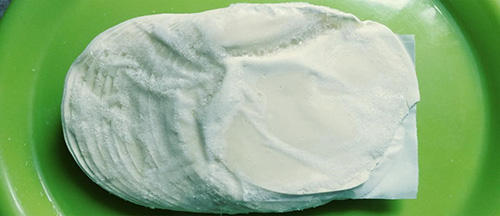 If that happens, it’s still safe to eat. You just might not find it appealing with the texture and flavor of the food not being up to par any longer. This might happen if the temperature has not been consistent. Notice the frozen cheese in the photo below, with ice crystals directly on it. I thawed this, and while it could be digested, the quality wasn’t very good. It was dry and had lost some flavor.
If that happens, it’s still safe to eat. You just might not find it appealing with the texture and flavor of the food not being up to par any longer. This might happen if the temperature has not been consistent. Notice the frozen cheese in the photo below, with ice crystals directly on it. I thawed this, and while it could be digested, the quality wasn’t very good. It was dry and had lost some flavor.
Related: My First Batch Of Canned Cheese
Discoloration in Proteins
If the fresh red-colored steak you placed in the freezer is now looking a bit discolored, such as grey or brown, it probably was exposed to some air. It should still be OK to eat, but not the highest in quality. It might turn out leathery or dry after cooking it. In the photo below, you can see that the beef is fairly dark. I thawed and cooked it, and it was edible. But, not nearly as good as the one I cooked without the discoloration weeks earlier.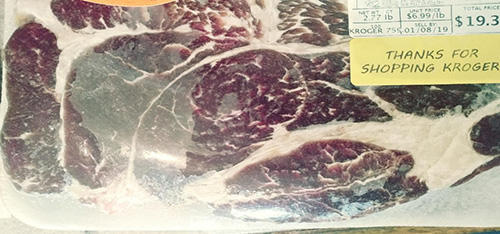
Dull Veggies
If the bright green broccoli or green beans you put in the freezer are now looking a little pale or dull, it’s a good sign that the flavor and texture might not be as great either after thawing. The reason is because it has dried out too much while in the freezer. In the following photo, you can see the beans starting to do what I am talking about. The color isn’t as bright and the texture seems drier than when I first bought them. They are still worth cooking up though, rather than throwing them out.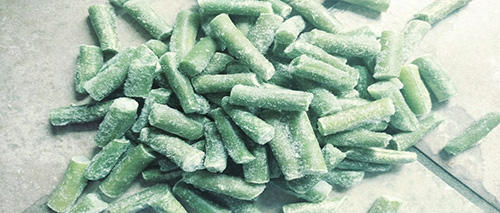
Unsure When It Went into the Freezer
We have probably all done it, at least once. This is one area that I am trying very hard to get better at…writing the date on the package when I put it in the freezer. Unfortunately, the freezer isn’t meant to store things indefinitely. The quality of any food will deteriorate eventually. And from there, refer to the government’s guidelines for Food Safety to know the recommended limits for certain foods.
Related: 7 Super Cheap Foods To Stockpile That People Usually Throw Away
When It’s No Longer Safe to Consume
There comes a time when it’s not a matter of quality, but safety instead, and the food should be thrown out, period. Here is what to look for to know if your food is no longer safe to consume…
Evidence of Spills
If you see any pooling of what looks like juice from meat, you have a problem. That could indicate the freezer temperature rose above freezing, either through a power outage or a breakdown of the freezer, and something thawed. It could also be from meats dripping prior to it freezing. It’s hard to know if that juice contaminated any other food. The safest thing to do would be to throw anything out that has evidence of contact with that juice.
Bad Odor
This one is tricky, because you might not be able to smell if anything is off until it’s thawed out. But, if the food smells rancid or off at all …especially meat or fish, throw it out. It most likely didn’t freeze in time to save it, or it thawed for some reason after it was frozen.
Slimy or Sticky
If the defrosted food item feels slimy or sticky, it’s a sign that the food has gone bad. Again, it’s most likely because it thawed at some point, or was already bad before going in the freezer.
These are all signs of foods you shouldn’t hesitate on throwing out. Don’t take a chance!
Shelf Life in the Freezer
When it comes to the freezer, not all foods were created equal. Although foods can be kept indefinitely in a freezer if it’s kept at a constant temperature of 0°F or below, the quality starts to wane after a while. Instead of guessing how long a certain food item should last in the freezer without sacrificing quality, here is a pretty good guide to follow:
- Hot Dogs – up to 2 months
- Lunch meat – up to 2 months
- Bacon – up to 1 month
- Sausage – up to 2 months
- Ground meat – up to 4 months
- Steaks – up to 12 months
- Pork chops – up to 6 months
- Roasts – up to 12 months
- Whole chicken or turkey – up to 12 months
- Chicken or turkey pieces – up to 9 months
- Soups and stews – up to 3 months
- Cheese – up to 2 months
- Leftovers – up to 6 months
Once the foods are in the deep freeze longer than the recommended times above, you run the risk of it falling under the “bad” category. Edible, but the quality isn’t all that great.
Related: The Three-Year Shelf Life Viking Survival Food (With Pictures)
After a Power Outage
We’ve all probably experienced the dreaded power outage and have had to throw away a lot of food out of the refrigerator and freezer. But, did you know that you don’t always have to throw it all out? Foods that have thawed, or partially thawed, can be frozen again safely, IF the temperature of the food hasn’t risen above 40°F. The quality might suffer slightly, but safe at least. Just use a food thermometer to know the temperature.
You can use the following as a guide. If the food had thawed and was held above 40 °F for over 2 hours:
- Meats, poultry, and seafood – throw out
- Dairy (except hard cheese) – throw out
- Hard Cheese – refreeze
- Fruits – Refreeze, but throw out if there is mold, yeasty smell, or a sliminess develops.
- Veggies – throw out, if held above 40 °F for 6 hours or more
- Breads and pastries without a custard filling – refreeze
- Breads and pastries with a custard filling – throw out
- Casseroles, with pasta or rice – throw out
- Flour, cornmeal, or nuts – refreeze
- Waffles or pancakes – refreeze
- Frozen prepared meals – throw out
For food that still contains ice crystals and feels as cold as if it were in the refrigerator:
- Meats, poultry, and seafood – refreeze
- Dairy (except ice cream and frozen yogurt) – refreeze
- Ice cream or frozen yogurt – throw out
- Fruits – refreeze
- Veggies – refreeze
- Breads and pastries without a custard filling – refreeze
- Breads and pastries with a custard filling – refreeze
- Casseroles, with pasta or rice – refreeze
- Flour, cornmeal, or nuts – refreeze
- Waffles or pancakes – refreeze
- Frozen prepared meals – refreeze
The information above is given out by the government for Food and Safety, not just a guess. But, if you are still unsure with all the information in this article, you can adopt my motto: When in doubt, throw it out.
You may also like:
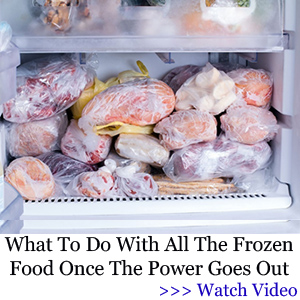 Why You Should Put A Silver Coin In Water
Why You Should Put A Silver Coin In Water
5 Ingenious Ways To Refrigerate Your Food Without Electricity (Video)
The Only 15 Rules for Your Prepper Pantry

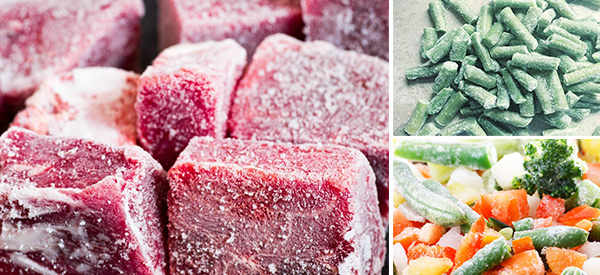













There’s a lot of helpful info in this post for people who are learning about their freezers.
One thing that’ll extend the life of your freezer storage is to double wrap your meat items.
The “Shelf life in the freezer” section took me by surprise though; in my opinion the time table is way off. I’ve stored poultry, rabbit, beef, pork, venison, and all sorts of processed meats from grocery stores for over a year, in some cases, two years, (the pkgs that got lost) and I’ve never gotten sick. The quality degradation wasn’t noticable either, but we do double wrap. Pork doesn’t last as long as other meats, so if it’s over a year old we check it carefully as this post suggests. …..Hot Dogs? Up to 2 months??? Heck… They’ll last that long in the frig.
You forgot the most important thing to preserve foods in the freezer, vacuum packaging. With the air removed in the package, it is harder for freezer burn to occur. And some bacteria can’t survive without oxygen.
Totally agree. Meat we buy is brought home, removed from packaging, then vacuum packaged. A few days ago, I came across a package of “vintage” 5-year old ground pork. Doubting it was any good we tried it anyway. It tasted great!
Unfortunately, bacteria that can survive without oxygen (anaerobic), are more dangerous like Botulinum. That’s why potassium nitrate (gunpowder) was added to salt to make ham etc. And for vegetables, a little boron (can be toxic if too much). Both kill botulinum bacteria but not the toxin once released.
Recently I decided to do a inventory of my chest freezer…at the bottom I found a frozen turkey that was anywhere from two to three years old…I decided to give it a run on a weekend…it was delicious as if I had just purchased it…of course it was still wrapped in the plastic that it comes with from the store..I believe that the life of frozen items all depends on how it is wrapped..one of those seal a meal machine does the best job of preserving food…
It is also packaged in a certain amount of water which helps prevent freezer burn.
Yes I agree with what you saying about frozen foods in the freezer with caution. We had some game meat from four years ago at the bottom while cleaning and said ya right on some elk roast and roasted it up and smelled good and all but ate a good portion of it and was poisoned and sick for a good 36hrs mistake to never try this again. As you say One year is safe after this, always throw away food that’s been in the freezer more than a year.
To tell if your freezer has thawed and refrozen while you were away, take a plastic bottle, fill halfway with water, lay in side in freezer , after it freezes stand it upright in freezer. If ice has melted to bottom and is not up the side of the bottle, power has been out
Regards to knowing if power is off…one other way..small container of water…freeze it…then open the freezer and put a quarter on top of the ice…if the freezer has defrosted when you check the quarter will be at the bottom of the container …very handy…
Fill a small dish with water and place in freezer. After frozen put a coin on top. You can then tell if your freezer thawed and refroze.
InstantPot pressure cooker! That’s what I use on all the old or freezer-burnt surprises. I’ve actually tossed the surprise in the pot still frozen and it has always come out great. DH is bad about rotating the freezer and there always seems to be that one thing that hides. And I agree on the shelf-life section, mine seems to last far longer than what’s listed in the article.
In this age of litigation, it is far better to err on the side of safety than to skate on thin ice. Seventy-five years ago the times would have been much longer. This is the age of the sue ’em lottery.
Among other court reforms, we need reformation that would make litigants and lawyers liable for attorney fees when they lose a suit. That’s the law in England, and while I don’t agree with most of what passes for law in England, that is one provision that I think this country needs.
I haven’t sat down and sketched out the details of how it would work because I know the Trial Lawyers Assoc. would be dead set against it and they maintain a powerful lobby in state capitols and in the District of Corruption.
Thank you for researching this subject. To dovetail on what’s already been said, yes I too have frozen food that lasts much longer. I suspect there are several factors that went into determining the government established storage lengths from food lobbyist to legal to product type and product prep. I vacuum seal, date the food, and then place them in the plastic bag that I brought them home in and date that. From my experiences, I’ve found that my storage lengths are easily about double what’s listed.
To all hunters & fishermen. I vacuum pack all roasts & steaks so my venison lasts almost forever w/o freezer burn. I place all doves, pheasant, ducks & geese covered in water to last indefinitely. I also freeze shrimp & fish in water covered containers. Covered in water & frozen lasts & lasts. I save cardboard milk containers which stack great in a freezer& are free!
I just gave some elk that was marked “07” (this is 2020) to a neighbor for his dog. Inasmuch as it is game meat I am sure the dog will gobble it down with no problem. Personally, even though it was still probably good as it was double wrapped by the butcher shop, I wasn’t feeling particularly lucky this week, so decided to give the dogs a thrill.